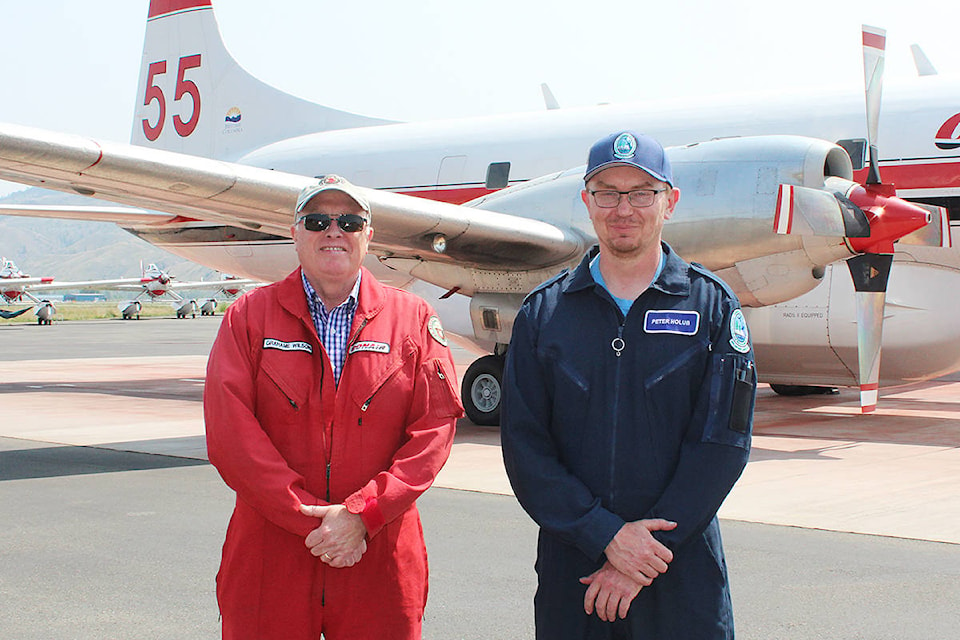Perhaps nobody understands the magnitude of a wildfire better than those who fly above to combat the blaze.
Grahame Wilson, an air tanker pilot with the BC Wildfire Service, and Peter Holub, an air attack officer for Conair Aerial Firefighting, were among the many crews who fought the Gustafsen and Elephant Hill fires last summer.
“You just have to accept that quite often mother nature is in charge and it’s a very powerful force and I’m just one man,” said Wilson, who has been flying an air tanker for 35 years.
In a phone interview from a base in Kamloops, the men recalled their experiences during some of the worst wildfires in B.C. history.
The lowest point for both Wilson and Holub was watching structures burn.
Wilson said the memory of the Cache Creek airport hangers catching on fire is a memory that sticks with him.
“I knew there was airplanes inside them that would be gone,” he said.
For Holub, it was the Boston Flats mobile home park. He said he remembers exactly which tanker he flew over the park and that he got “a sickening feeling” witnessing them burn.
“For probably two months I debriefed on that fire, itself,” he said.
RELATED: Land recovery one year after Elephant Hill and Gustafsen wildfires
Air attack officers and air tanker pilots are in constant communication with each other and with central dispatch.
The air attack officer serves as the first eyes on a fire. The birddog plane - most commonly the turbo commander 690 - is flown over to analyze and determine what resources will be needed and what challenges they’ll have to overcome.
Only after these factors are determined is the tanker directed where to go.
“No tanker can do a drop without an air attack officer directing it,” said Holub, who was a ground firefighter before taking to the skies in 2003.
It’s a responsibility that carries weight, a weight Holub admits that can be “very mentally exhausting.”
While he was busy flying over last year’s flames, his family was being evacuated from their home in Williams Lake.
“You’re so focused on what you’re doing, you really don’t have time to think about other stuff.”
He said he received a few texts and photos of what was happening back home, but that, “We’re communicating with tankers, ground crews, helicopters, coordinating the whole air attack and there’s lots going on, so really, at the end of the day, I just couldn’t think about it.”
RELATED: How South Cariboo fire departments dealt with and were affected by last summer’s wildfires
Although there’s no way to train for every aspect of the job, and Holub said there’s a lot of on-the-spot learning, crews are thoroughly tested for their ability to cope under stress.
For Wilson, a simple morning walk is a suitable stress reliever. After exceptionally difficult days, he said he sometimes feels as if he’s still flying in his sleep. Fighting the Elephant Hill fire resulted in a few nights like this.
Wilson’s family, who live in Victoria, may not have been in danger, but there’s no way to avoid the worry that comes with separation.
“I phone both my wife and my mother every night to let them know I’m safely on the ground to try and help them with that,” he said.
The crew’s safety is the first priority when fighting wildfires. Aerial workers are limited to a maximum 14 hour day, with no more than eight hours of flight time. They check in on each other, as well, to make sure nobody is over-exerting themselves.
Wilson and Holub are both back in the skies for another wildfire season.
One thing both men have learned from last summer is that they can follow all the guidelines, standards and procedures, but there are some things you can’t control - dry, light fuels and 60 km/h winds pushing fire at a rate of 100 metres per minute, for example.
“We don’t always win, as hard as you might try,” said Wilson.
As of Wednesday, July 25, Wilson was stationed in Kamloops, waiting for his next assignment. Holub was headed out to Cranbrook.
beth.audet@100milefreepress.net
Like us on Facebook and follow us on Twitter.
